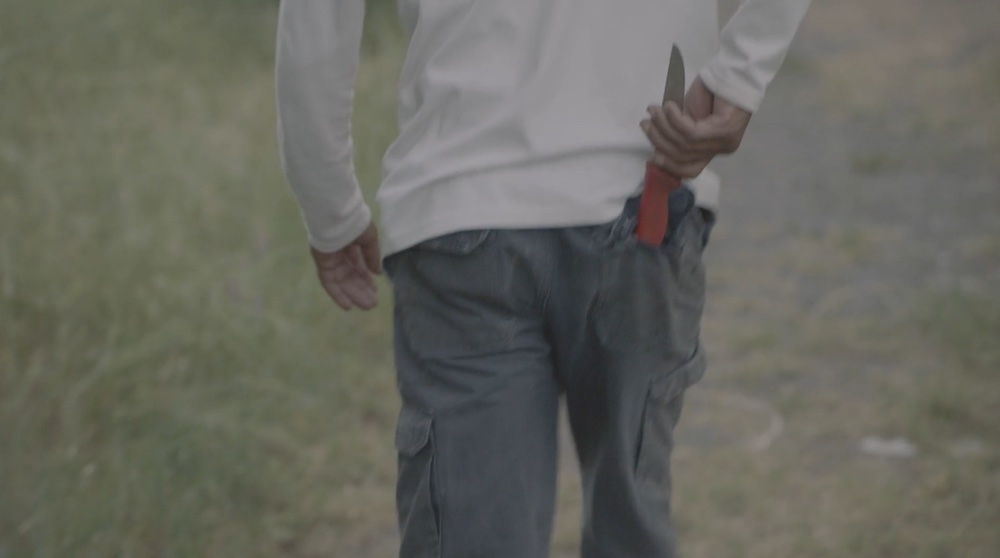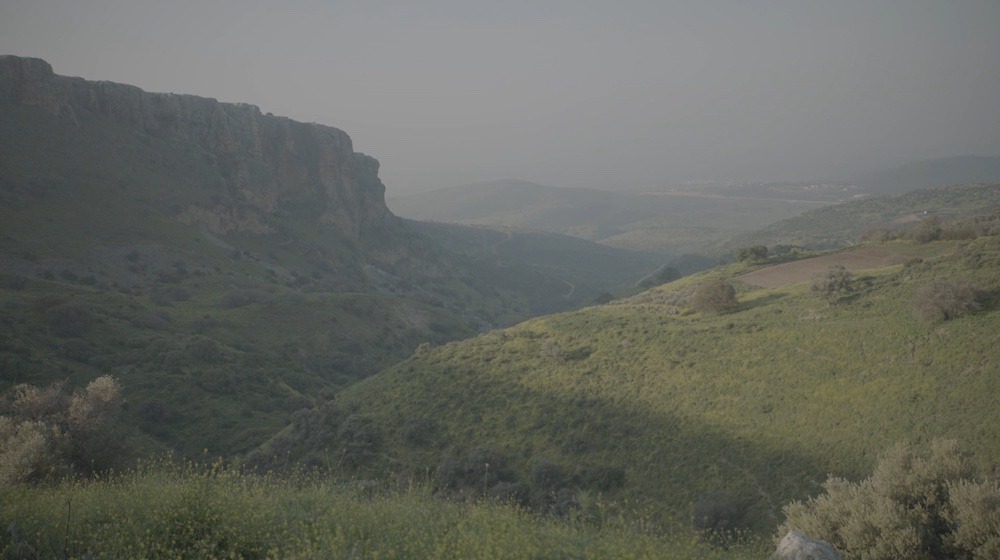In “Foragers,” a video installation by Palestinian artist Jumana Manna (on view at Berkeley Art Museum through March), Palestinians walk through a countryside of thistles and thyme, red poppies and chamomile, harvesting native herbs and cutting their thorns before carefully placing them into bags.
The subject of the film is two herbs indigenous to Palestine: that wild thyme and wild thistle known respectively as za’atar and ‘akkoub. The same plants also grow throughout Iraq, Syria, and Lebanon. The only country to have banned their wild harvesting is Israel. The Israeli state created the Israeli Nature and Parks Authority to regulate, and ultimately, to criminalize, the wild harvesting of the indigenous herb by Palestinians.
Thus, the herb is both a metaphor and a fact of indigenous life under occupation. The herbs are a metaphor for indigeneity, for a perennial and inherent wildness that does not answer to contrived authority of the occupying regime. At the same time, the herbs are also quite literally food that provides the occasion for social gatherings, and is exchanged among family members, relations and neighbors, and is medicinal—a part of the fabric of Palestinian life.
When the film opens, we see scenes shot from above by drone, the choppy, digital, militaristic film technology that immediately reminds us that surveillance is at the center of the occupation. Early in the film, we see an act of sabotage when a man slashes the tires of a Nature Authority truck. Perhaps the out-of-commission truck will allow the Palestinian villagers a day of herb gathering without being “controlled” and issued fines of up to US$1000. In one scene, a forager spots a controller and signals to the others, who drop into the tall grass like wild hares eluding a predator. We see that the Israeli state has created a matrix of oppression, of which the herbs are only one part.

When the camera finally makes its way out of the wild countryside landscape to the Israeli courthouse where the illegal herb foraging is adjudicated, the eyes require adjusting. The courthouse is so new looking that it almost seems like it hasn’t yet been built—like an architectural rendering of a future development. But then, isn’t that what this is all about? The future telling the past what the ancient laws actually are?
The Palestinian foragers, when questioned by the Israeli judge about their foraging, have a number of reasonable responses:
“Za’aatar needs to be trimmed, like all plants. The more its clipped, the stronger it grows back.”
And, “We’ve been foraging from this land for all our lives. Since the age of my father and grandfather. Next year it will grow back and we will do the same.”
“What protected species? This land isn’t yours, and neither is this plant.”
The responses of the foragers are a Socratic circle of reasoning, each answer building upon the last and arriving closer and closer to the truth of the question of the herb, the land, the occupation.
Finally, “I am nature. Nature is me.” The Israeli state may have invented a “Nature Authority,” but nature has no authorities.
Meanwhile, the Nature Authority drives ATVs over the habitat, and, somewhere off camera, bulldozers destroy yet more habitat to build yet more illegal settlements upon which fields of wild herbs once grew.
Not all za’atar and ‘akkoub grows in the wild, we learn. It is also cultivated on two “plantations” associated with a neighboring kibbutz. An older man who manages one of the farms explains the set-up: The Palestinians can’t start their own plantations because they can’t afford to buy land insurance, which is required by the Israeli government and is prohibitively expensive. So they forage, risking criminalization. As the contradictions in his explanation become more apparent, the man smiles sheepishly and walks off camera. “Don’t make me talk anymore.”

When the foragers are caught, the Nature Authority makes them dump the herbs on the ground. The scene is reminiscent of the photos that American police sometimes post of drug busts (including legal ones like marijuana) or even cash, stolen through civil forfeiture. At one point, Jefferson Airplane’s “White Rabbit” plays in a found footage clip of Israeli TV (a “cynical choice” says the artist), further reinforcing the drug reference and the notion that any inherent criminality to be found in various commodities is a largely created phenomenon.
Later in the film, armed with a flashlight and his three yellow labs, a man goes back at night and retrieves the herbs that the authorities made him dump on the ground. He walks home and puts the bag of herbs in the fridge, adjusting the bag so the herbs can breathe, and aren’t crushed, almost as if he’s tucking them into bed. In the next frame, he tucks himself into bed, and is then joined by his dogs. It is one of the most beautiful scenes in the film, of which there are many.
In another scene, the moon glows on the horizon. It feels somehow remarkable that it is the same pareidolic face of the moon that tilts sympathetically down at us in the Western US. From one forager’s house, we can see a bead of settlements on the hillside, like caterpillars, like luxury condos, like little glowing Salesforce towers.
In an artist’s talk at the Berkeley Art Museum, Manna spoke of the “camera language” of the film. While some of the footage is collected by drone or appears to look through the binoculars of some surveilling eye, Manna also uses what she referrs to as a “foraging camera”, a camera that is in search of the image. The camera is foraging for the plant, and in the process finds feet, bags, animals and other untold signs of life.
“Cinema does not need to over-inform the audience,” says Manna, which perhaps is why this is a video installation, and not a documentary film. Manna gives us the essential elements and we can put together the rest.
When discussing the origin of the film, Manna says “Before the film became about the police and the law, it was about the magic of foraging and the beauty of Palestine in the spring.”
But the beauty of Palestine, and the presence of joy, is still everywhere in the film: in the lighting of a cigarette at the end of a long day, in the hugging of a dog, in smile lines deeply etched into a tired face, in the flowers. And in the herbs that do grow back, year after year.
FORAGERS is currently on view at the Berkeley Art Museum through March. More info here.





